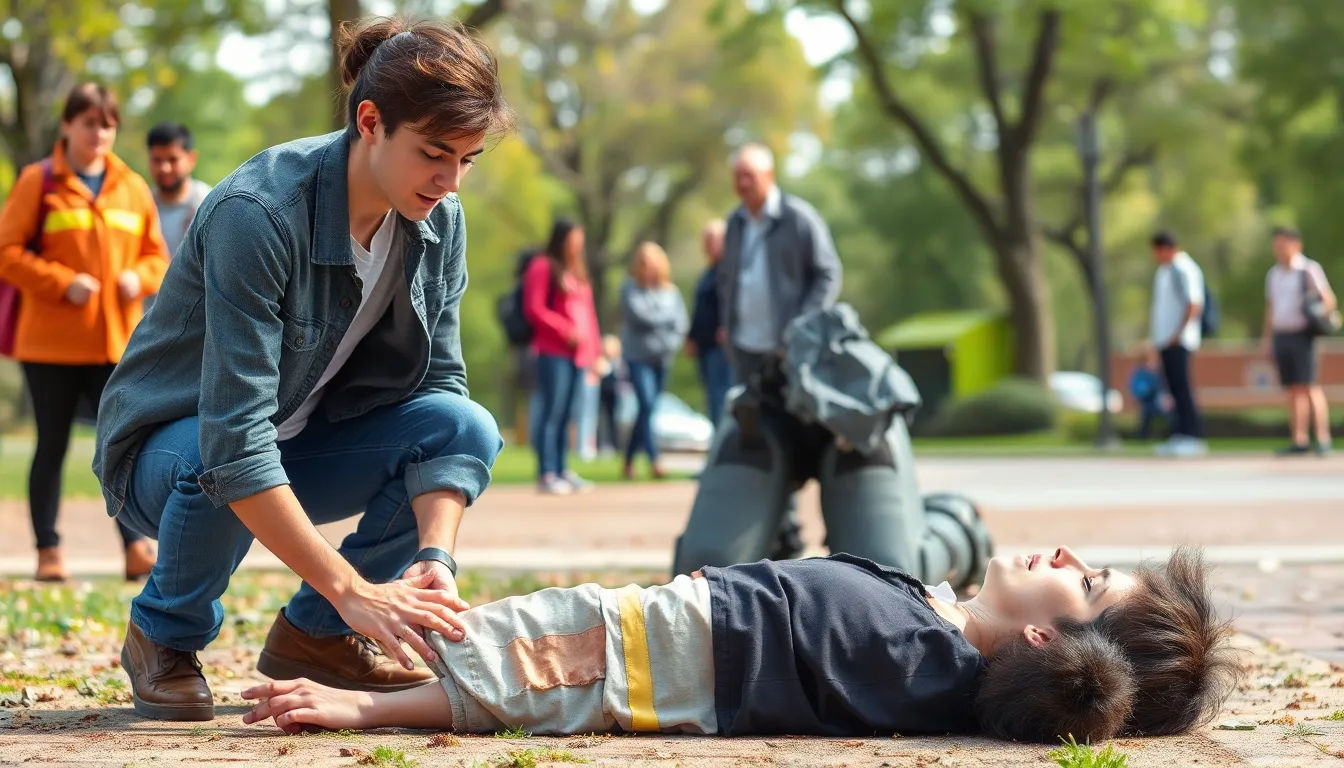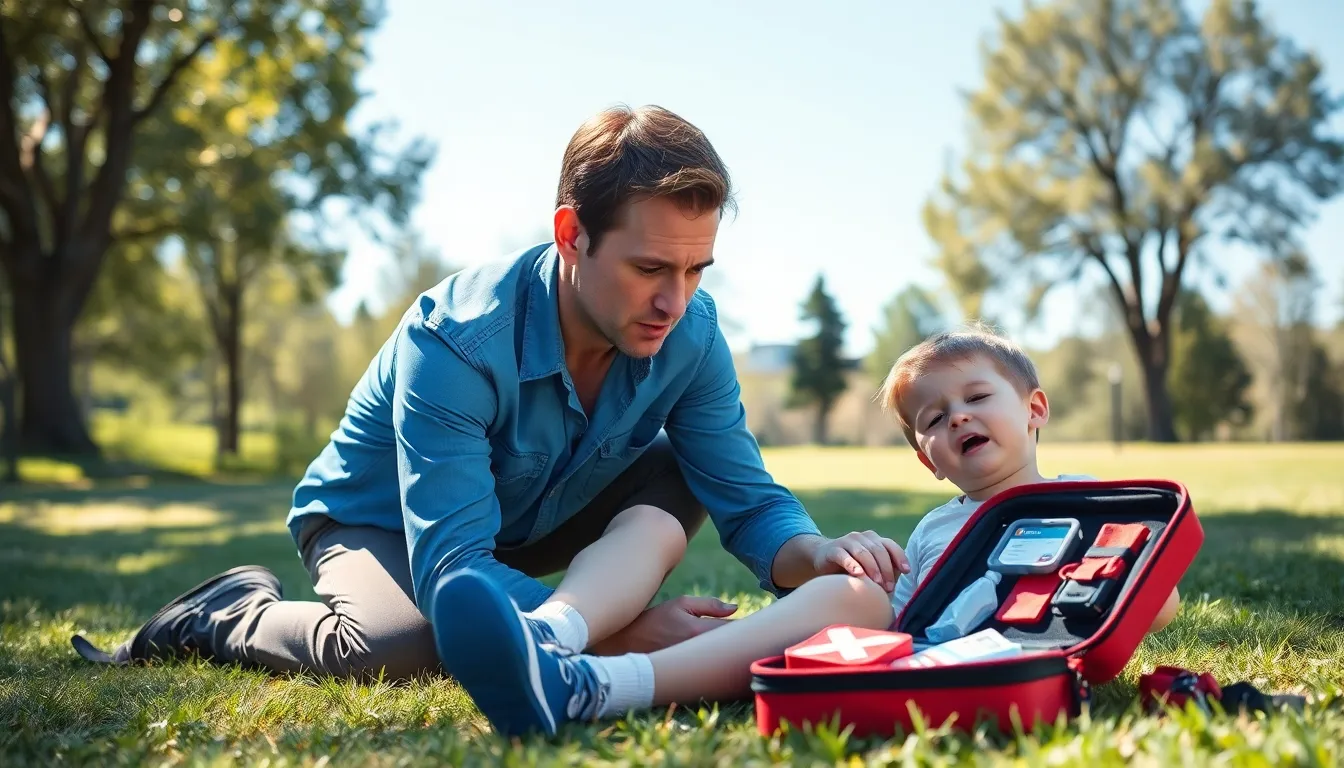When life throws a curveball, it often lands right on your toe. Emergency injuries can happen in the blink of an eye, turning a fun day into a trip to the ER faster than you can say “band-aid.” Whether it’s a slip on the dance floor or a kitchen mishap that leaves you with more than just a bruised ego, knowing how to handle these situations can make all the difference.
Table of Contents
ToggleUnderstanding Emergency Injuries
Emergency injuries arise suddenly, often turning normal activities into crises requiring immediate care. Recognizing these injuries becomes essential for effective management.
Definition of Emergency Injuries
Emergency injuries refer to unexpected physical traumas needing urgent medical attention. Such injuries can stem from accidents like falls, cuts, or burns. Individuals often experience pain, bleeding, or inability to move affected body parts. Quick identification and response can reduce complications and promote faster recovery.
Common Types of Emergency Injuries
Common types of emergency injuries include fractures, which involve breaks in bones, and sprains, affecting ligaments. Cuts and lacerations occur frequently and may require stitches for proper healing. Burns arise from heat sources or chemicals, varying in severity. Additionally, head injuries can lead to serious complications, including concussions. Each type necessitates specific first aid responses tailored to its nature.
Causes of Emergency Injuries

Emergency injuries can stem from various causes, each demanding immediate attention. Understanding these causes aids in prevention and response.
Accidents
Accidents frequently lead to emergency injuries. Common incidents include falls, vehicle collisions, and sports injuries. Each scenario can result in fractures, sprains, or cuts requiring urgent care. Additionally, domestic accidents like kitchen mishaps contribute significantly to injury statistics. According to the National Safety Council, more than 35 million falls occur annually in the U.S., prompting emergency room visits. Therefore, being mindful of surroundings and practicing safety can reduce these risks.
Environmental Factors
Environmental factors also play a crucial role in emergency injuries. Weather conditions such as rain, snow, or ice increase the likelihood of slips and falls. Inadequate lighting in public areas further exacerbates these hazards, leading individuals to trip or stumble. Furthermore, poorly maintained public infrastructure can pose serious threats. According to the Centers for Disease Control and Prevention, over 800,000 patients annually require hospitalization due to falls related to environmental factors. Awareness and proactive measures can help mitigate these dangers.
Medical Emergencies
Medical emergencies encompass a broad range of scenarios, including heart attacks, strokes, and allergic reactions. Each condition can arise unexpectedly, necessitating quick action and proper first aid response. Individuals experiencing chest pain or shortness of breath should seek immediate medical assistance, as these symptoms may indicate a heart attack. The American Heart Association highlights that approximately 805,000 Americans suffer heart attacks each year. Quick identification of medical emergencies increases the chance of favorable outcomes and enhances recovery prospects.
Treatment Protocols for Emergency Injuries
Effective management of emergency injuries requires structured treatment protocols. These protocols consist of three main components: initial assessment, first aid techniques, and guidance on when to seek professional help.
Initial Assessment
Initially assessing the situation is crucial for ensuring safety. The focus should be on evaluating the extent of the injury and determining if immediate medical assistance is necessary. He or she should check for responsiveness; if the person reacts, gather information about the injury. Evaluating the patient’s vital signs, such as breathing and heart rate, provides insight into the severity of the situation. Observing for visible injuries, like bleeding or deformities, helps prioritize first aid actions and aids in decision-making for further treatment.
First Aid Techniques
First aid techniques vary depending on the type of injury. For cuts, applying direct pressure with a clean cloth stops bleeding. In cases of burns, cooling the affected area with running water reduces tissue damage. When dealing with sprains, immobilizing the injured limb while elevating it helps minimize swelling. An important technique for fractures involves stabilizing the affected area without attempting to realign the bone. For head injuries, monitoring for signs of concussion or other complications is essential. Each technique can significantly impact recovery and prevent further complications.
When to Seek Professional Help
Recognizing when to seek professional help is vital in emergency situations. If bleeding remains uncontrolled or a severe head injury occurs, calling emergency services becomes necessary. Difficulty breathing indicates a critical need for immediate medical attention. Convulsions or signs of shock, such as persistent dizziness or confusion, warrant prompt intervention. In cases of suspected heart attacks, every minute counts, making it imperative to act swiftly. Staying vigilant about these indicators can enhance outcomes and recovery potential.
Prevention Strategies
Preventing emergency injuries requires proactive measures in various settings. Implementing strategies at home, workplaces, and within communities enhances safety for everyone.
Safety Measures at Home
Fortifying safety at home includes ensuring proper lighting in hallways and staircases. Keeping commonly used items within easy reach reduces the risk of falls. Installing non-slip mats in kitchens and bathrooms prevents accidents on wet surfaces. Regularly checking smoke detectors and carbon monoxide alarms adds an extra layer of protection. Educating family members about potential hazards, such as sharp kitchen tools and hot surfaces, fosters a safer environment.
Workplace Safety Initiatives
Employers should incorporate comprehensive safety training programs for employees. Providing personal protective equipment, like helmets or gloves, minimizes injury risks during hazardous tasks. Regular workplace inspections identify potential hazards, promoting a culture of safety. Encouraging open communication regarding safety concerns empowers employees to report risks. Eye protection and ergonomic furniture help prevent injuries related to prolonged workstation use.
Community Awareness Programs
Communities benefit from engaging awareness programs focused on injury prevention. Residents should participate in workshops that educate about first aid and emergency response techniques. Neighborhood watch programs can host safety fairs, sharing tips on home and personal safety. Creating informative materials about local hazards, like poorly maintained streets, enhances community vigilance. Collaboration with local organizations promotes safety initiatives, reducing incident rates.
Emergency injuries can strike at any moment and knowing how to respond is vital. By understanding the types of injuries and their causes individuals can better prepare for unexpected situations. Effective management and timely intervention can significantly improve recovery outcomes.
Prevention remains a key element in reducing the risk of these injuries. Implementing safety measures at home and in the workplace can create a safer environment for everyone. Community education on injury prevention and first aid further enhances readiness.
Staying informed and proactive not only protects oneself but also contributes to the safety of others. With the right knowledge and preparation emergency injuries can be managed effectively, ensuring a quicker return to normalcy.



